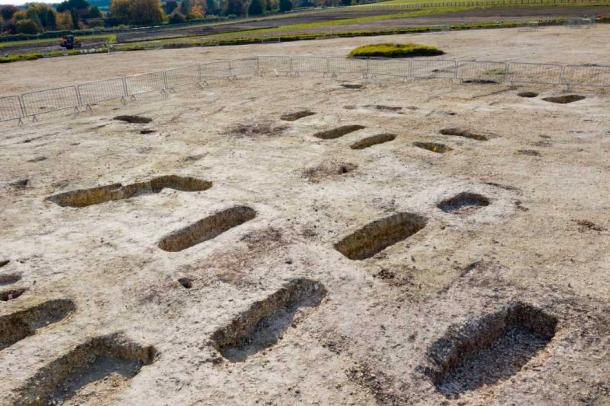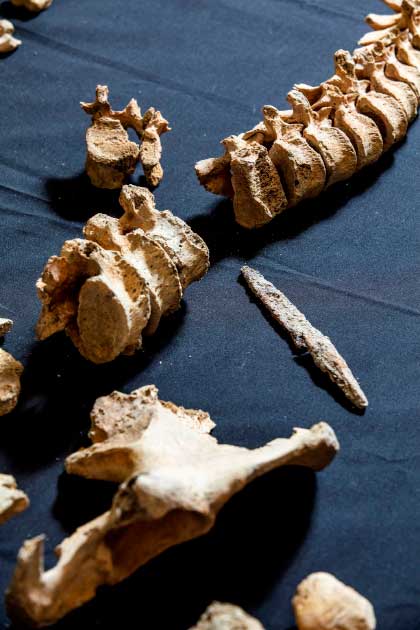Archaeologists who’ve launched exploratory digs along the path of the HS2 high-speed rail project in England have made some fascinating and amazing discoveries. The latest addition to the list of remarkable finds was unearthed near Wendover, Buckinghamshire, as a team of archaeologists affiliated with the private contractor Fusion JV successfully excavated a 1,500-year-old Anglo-Saxon cemetery that contained the graves of 141 men, women, and children. The amazing discoveries were described in a HS2 press release .
This remarkable Anglo-Saxon cemetery, which was occupied by people who lived and died in the fifth and sixth centuries AD, is one of the largest Anglo-Saxon graveyards ever found in England. In addition to the skeletal remains of the 141 individuals, the HS2 archaeologists also discovered a veritable gold mine of burial goods entombed alongside their deceased owners. They uncovered quite an eclectic range of items, including assorted types of jewelry, knives of various shapes and sizes, spearheads, fine glass bowls and beakers, belt buckles, more than 2,000 beads, ivory trinkets, and personal grooming tools such as ear wax removers, tweezers, and combs.

Site of the HS2 excavation of a huge Anglo-Saxon burial ground in Wendover, Buckinghamshire, England where 141 burials were uncovered along with a treasure trove of burial goods and artifacts. ( HS2)
The HS2 Wendover Anglo-Saxon Cemetery Sheds New Light On Era
“This stunning set of discoveries on the HS2 route can tell us more about how our predecessors lived, fought and ultimately died,” said popular historian and television presenter Dan Snow, who was quoted in a press release from HS2 announcing the exciting discovery. “It is one of the best and most revealing post Roman sites in the country and it was thrilling to join the team as they uncovered their wonderful finds.”
For a long time, little has been known about Anglo-Saxon culture and society in the first millennium AD. This is largely because artifacts from that era have rarely been recovered during archaeological digs.
But HS2 excavations have been taking place in many previously unexplored locations, and the ruins unearthed, and items recovered during these explorations are helping to fill in gaps in the historical record, including those associated with the Anglo-Saxon period 1,500 years ago.

A 6th century decorative footed pedestal bückelurn with three horns, decorated with cross stamps, found in a grave at the HS2 Wendover Anglo-Saxon site. ( HS2)
Countless Preserved Anglo-Saxon Culture Artifacts!
The HS2 Wendover Anglo-Saxon cemetery site has yielded 141 skeletons buried in 138 separate graves. Five cremation urns were also unearthed during the excavations.
One of the skeletons found in the cemetery, identified as a male between the ages of 17 and 24, was buried with a sharp iron object firmly embedded in his vertebrae.
A closer examination of the skeleton revealed he’d been stabbed to death by some type of weapon that had been thrust into his body from the front. His skeleton also featured a bright blue stain on the collarbone, which was left by a brooch that had been used to secure his clothing. His was one of several skeletons that had been buried with brooches that had been used to hold garments in place, often cloaks that were worn by men and long outer robes that were worn by women.

A possible male skeleton, aged 17-24, found with an iron spear point imbedded into his thoracic vertebra, excavated during HS2 archaeological work in Wendover. ( HS2)
One female skeleton was undoubtedly from a wealthy family, as buried alongside her was a large and impressive cache of valuable personal items. Her collection of burial goods included ornate glassware, many rings and brooches, iron belt fittings, and several objects that had been carved from ivory.
Dr. Rachel Wood, the lead archaeologist for Fusion JV on this project, described the unearthing of the huge Anglo-Saxon burial ground as a “once in a lifetime discovery.”
source: ancient-origins.net








